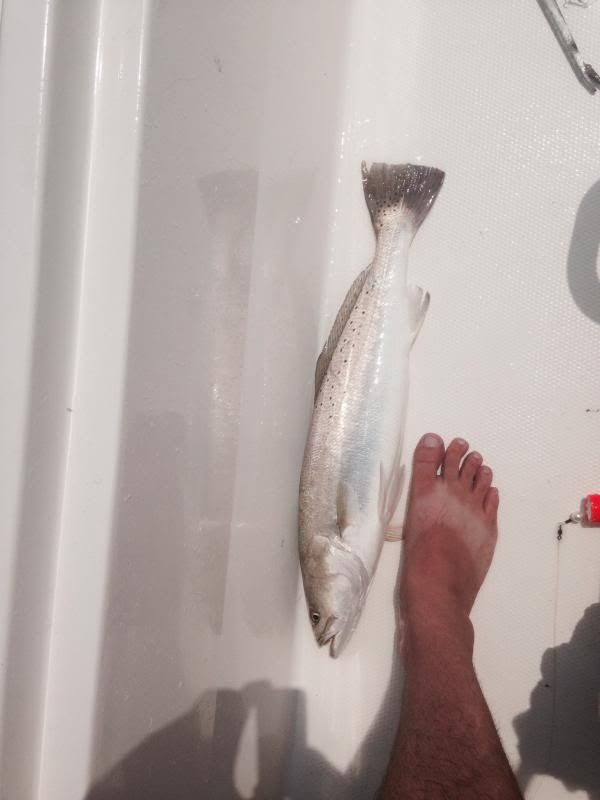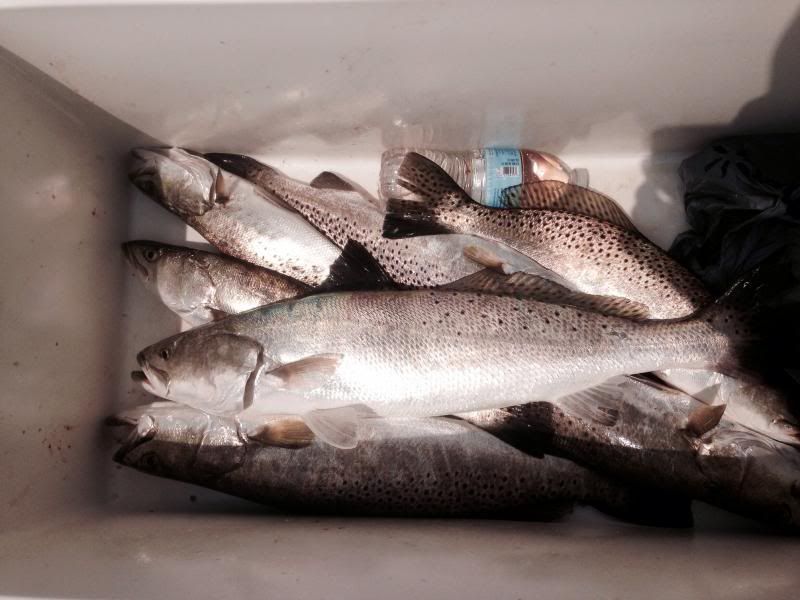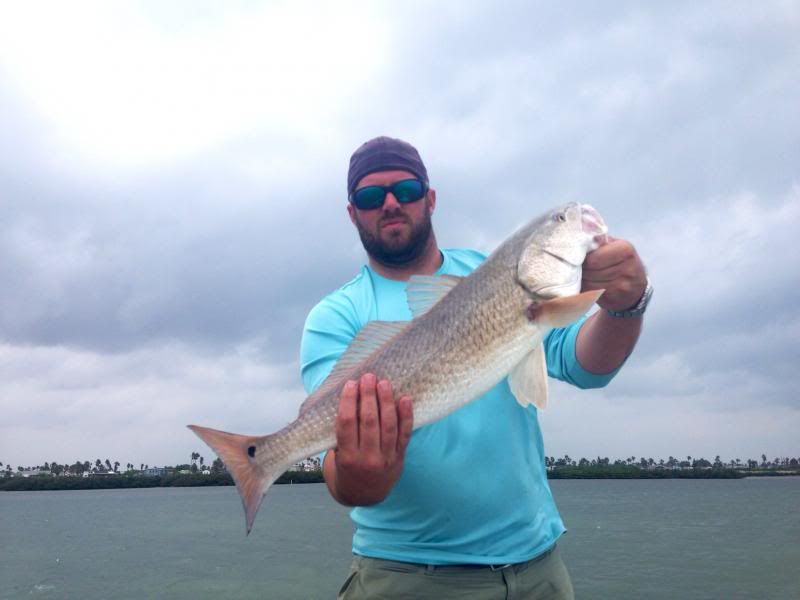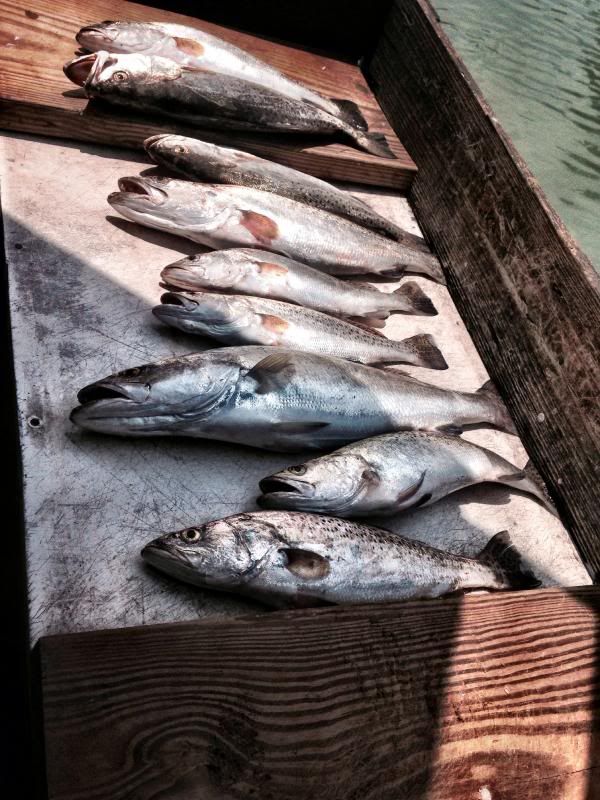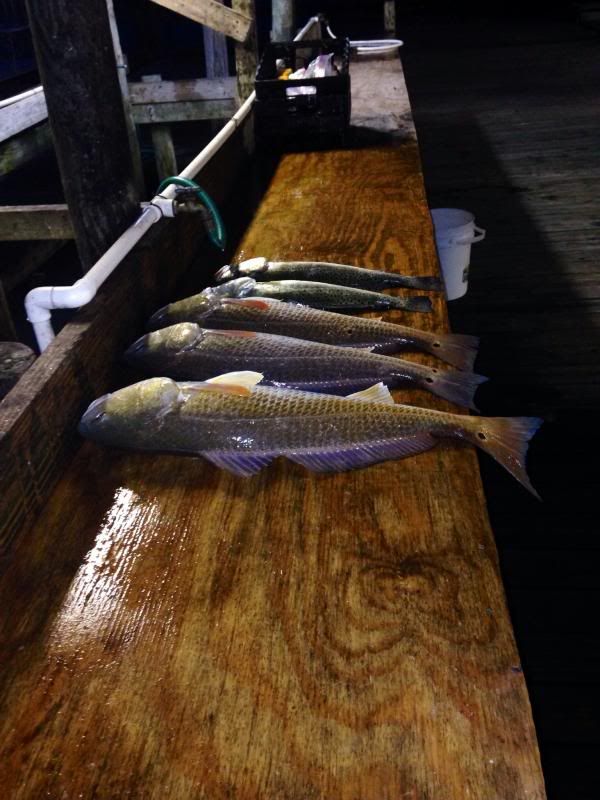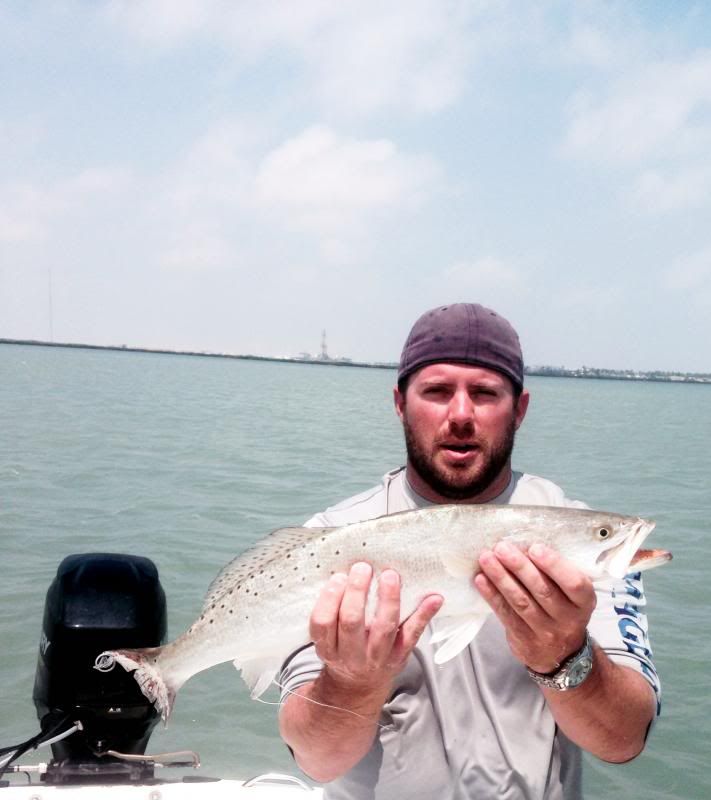No in-water use yet, so I can only report on what I have so far.
I'll post up another after I break it in.
This is rather long, if it does not interest you then you probably want to click away.
So this is my first new boat, so I’ll give you some background…My past experience has been a 14 foot runabout (with 25hp motor) when I was in my early 20’s and 2 months of ownership of an 18 foot Bayliner pleasure boat.
I’ve been in a boat on Copano bay and in party boats but other than that I’ve been landlocked regarding salt water.
Early this year the wife felt like if we had a boat we’d be on the fish more often. When the wife thinks buying a boat is a good idea, jump on it! So we began looking at what we could afford and began looking at some used boats
We wanted:
Bay and lake usage
Possibly pull a tube with one of the kids
Handle my wife, two kids, and I within the posted weight limit
Good gas mileage, and preferably easy to tow
Fit in the garage
Reliable and safe
Within our meager budget
Initially we looked used but the budget for used was around 6k, and I just didn’t see much where I really wanted to buy. I didn’t want to have to put a lot of work into a boat, or have something I didn’t fully trust.
I then saw the low payments on a new boat…holy **** they finance these things forever. I have good credit, no truck payments, and got a decent raise last year. I could afford a small number of new boats at a higher price than used. While I could easily get credit double of what I eventually settled on, I wanted a ‘starter boat’ with good gas mileage and something that would fit in the garage.
We then looked at some aluminum bass boats. The Crestliner was interesting, and the Bass Tracker had a ‘coastal’ edition that included vinyl flooring. The trailer had a swing hitch which fit in the garage nicely, and the boat had a lot of nice features like dual livewells. However the trailer was “galvashield” and not a pure galvanized trailer and the vinyl covering that replaced the carpet still had a lot of small areas where dirt could accumulate; it was merely a carpet replacement and didn’t look like it would hold up well over time. A bass boat just didn’t seem like a good bay boat, but the deal killer was the posted maximum weight was 575 pounds. The wife is light and the boys are about 300 pounds together. With my 210 pound self it was just not going to work. We fully understand that 4 people on a small boat will be VERY tight. I think the majority of the time we fish it will be 2-3 of us anyway.
So we glanced over at the Pro Skiff 17. This boat looked like something we were looking for. I prefer the v front rather than skiff or flat bottom, but the boat fit the bill. With the wide beam it also gave much more room in the front casting deck. The 850 pound capacity cleared the 4 of us and gear easily, 60hp motor is workable and fuel efficient. I know speed-wise this thing isn’t going to blast us around, but posted top speeds are around 34mph (not fully loaded of course). The video on the Mako site was interesting, and the external videos we found, plus one on the sales ladies phone when she rode one looked very nice.
I looked the boat up and down, and checked the threads here… I saw the snarky comments, the legitimate ones, and inspected the boat to see indeed where corners were cut. I’ve posted some pics below on those areas that highlight the types of things one might see on these. I was aware of that when buying the boat, but the price and utility of the boat looked to fit my need.
Two large casting decks, walk around room, yeti-clone, basic center console (made of the same plastic as the cooler it seems), a single small sealed storage area, all aluminum trailer, and not much else. Included is a single 6 gallon fuel tank, a single battery, the basic navigation lights, and something that I liked a lot: 100% composite construction.
The boat was $16,020 with the 60HP. It included free 5 year warranty on the Mercury engine and two years of “VIP” card at Bass Pro Shops. They had a deal that also included $500 gift card if purchased before April 16, basically dropping it to $15,520. I plan on using the gift card for a Lowrance HDS5 unit.
I watched the inventory drop as I procrastinated, and by the time I was ready to pull the trigger the only one they had left included trailer guides ($125) and spare wheel/tire ($175). I figured I was going to buy both so it really wasn’t too much more than originally intended.
The sales process was great; no pressure and no hassle. They answered my questions best they could, but they are obviously not as skilled or knowledgeable as a ‘real’ boat store. I think indeed they might offer a particular boat style or size to someone where it doesn’t best fit them. This is where I would recommend that true newbies or those who don’t want to do research should work with a ‘real’ boat store.
I submitted paperwork for the loan and got a great deal on financing. I went ahead and added the extended warranty, which I rarely do, that covers boat, motor, and trailer for 7 years. As long as I perform the proper maintenance, I shouldn’t have to do major repair work for awhile.
I had measured the boat more than once and knew that a 17’4” boat length does not include trailer tongue or engine. The total length was 22’4”. The downside is my garage is 20’ from wall to door. Even adding a swing hitch I was about 6” too short at best. Our youngest son had moved bedrooms and the bedroom directly on the other side of the garage was being used for bicycle storage. The wife was completely agreeable to cutting the wall with a notch for the engine if needed. I had never done destructive modifications to the house, but had a new sawzall in the box waiting for just such a need.
So on the big day I hit McClain trailers to pick up the Fulton Swing hitch, and then out to pick up the boat. We did the walk through with the prep person, fired up the engine and hooked it up to the truck. I pulled away and had a hard time believing that I actually have a boat behind the truck again.
I pulled into the garage and backed it all the way up. It barely but perfectly cleared the garage door opening. No T Top for me unless it folds down. You have to understand that I have motorcycles and bicycles in the garage so I had already moved around as much as I could. I couldn’t angle the boat in the garage. I knew the swing hitch alone wouldn’t allow the boat to fit so I pulled it forward, flipped the breakers, grabbed the sawzall, and began cutting. I carved out a nice notch just wide and tall enough for the motor and backed it up. I had a decision to make now. I could enlarge the hole which would take up much more of the room than already defined (currently I think I can go about 18” and have plenty of room with the swing hitch) or I could cut the trailer and install the swing hitch.
There is a very bad feeling when cutting up your brand new trailer. I moved the wires out of the way, scribed the line, and cut away. After slowly drilling all 16 holes, installing, and properly tightening the bolts the trailer was essentially one piece again. With the swing hitch, and the notched garage, I now have the boat fitting into the garage as intended.
A late night with the hitch but I would be ready for the motor break in on Lake Conroe, I had thought.
A strong wind blew on Saturday and Sunday so I sat in the garage and made motor noises.
I plan on heading out next weekend for a couple of break in runs, I’ll post back my thoughts then.
Pictures to follow, I tried to focus on areas of the boat you don't see on the Mako site, and the 'bad' things that I could find. The Mako site has plenty of beauty shots.
The battery and fuel tank are held in with Stainless screws but the cooler and rod holders are not - I'll replace the cooler tie down screws with stainless.
Any other advice for prep or things I am missing to install/update would be very welcome.
I plan on adding a VHF radio, the Lowrance HDS5, a small battery for the electronics and possible amplifier and Mp3 player, spare tank (3 or 6 gallon?), mount some rod holders to the back of the cooler (using 5200?), and a second, smaller, cooler mounted to the bow casting deck for fish.
I'll post up another after I break it in.
This is rather long, if it does not interest you then you probably want to click away.
So this is my first new boat, so I’ll give you some background…My past experience has been a 14 foot runabout (with 25hp motor) when I was in my early 20’s and 2 months of ownership of an 18 foot Bayliner pleasure boat.
I’ve been in a boat on Copano bay and in party boats but other than that I’ve been landlocked regarding salt water.
Early this year the wife felt like if we had a boat we’d be on the fish more often. When the wife thinks buying a boat is a good idea, jump on it! So we began looking at what we could afford and began looking at some used boats
We wanted:
Bay and lake usage
Possibly pull a tube with one of the kids
Handle my wife, two kids, and I within the posted weight limit
Good gas mileage, and preferably easy to tow
Fit in the garage
Reliable and safe
Within our meager budget
Initially we looked used but the budget for used was around 6k, and I just didn’t see much where I really wanted to buy. I didn’t want to have to put a lot of work into a boat, or have something I didn’t fully trust.
I then saw the low payments on a new boat…holy **** they finance these things forever. I have good credit, no truck payments, and got a decent raise last year. I could afford a small number of new boats at a higher price than used. While I could easily get credit double of what I eventually settled on, I wanted a ‘starter boat’ with good gas mileage and something that would fit in the garage.
We then looked at some aluminum bass boats. The Crestliner was interesting, and the Bass Tracker had a ‘coastal’ edition that included vinyl flooring. The trailer had a swing hitch which fit in the garage nicely, and the boat had a lot of nice features like dual livewells. However the trailer was “galvashield” and not a pure galvanized trailer and the vinyl covering that replaced the carpet still had a lot of small areas where dirt could accumulate; it was merely a carpet replacement and didn’t look like it would hold up well over time. A bass boat just didn’t seem like a good bay boat, but the deal killer was the posted maximum weight was 575 pounds. The wife is light and the boys are about 300 pounds together. With my 210 pound self it was just not going to work. We fully understand that 4 people on a small boat will be VERY tight. I think the majority of the time we fish it will be 2-3 of us anyway.
So we glanced over at the Pro Skiff 17. This boat looked like something we were looking for. I prefer the v front rather than skiff or flat bottom, but the boat fit the bill. With the wide beam it also gave much more room in the front casting deck. The 850 pound capacity cleared the 4 of us and gear easily, 60hp motor is workable and fuel efficient. I know speed-wise this thing isn’t going to blast us around, but posted top speeds are around 34mph (not fully loaded of course). The video on the Mako site was interesting, and the external videos we found, plus one on the sales ladies phone when she rode one looked very nice.
I looked the boat up and down, and checked the threads here… I saw the snarky comments, the legitimate ones, and inspected the boat to see indeed where corners were cut. I’ve posted some pics below on those areas that highlight the types of things one might see on these. I was aware of that when buying the boat, but the price and utility of the boat looked to fit my need.
Two large casting decks, walk around room, yeti-clone, basic center console (made of the same plastic as the cooler it seems), a single small sealed storage area, all aluminum trailer, and not much else. Included is a single 6 gallon fuel tank, a single battery, the basic navigation lights, and something that I liked a lot: 100% composite construction.
The boat was $16,020 with the 60HP. It included free 5 year warranty on the Mercury engine and two years of “VIP” card at Bass Pro Shops. They had a deal that also included $500 gift card if purchased before April 16, basically dropping it to $15,520. I plan on using the gift card for a Lowrance HDS5 unit.
I watched the inventory drop as I procrastinated, and by the time I was ready to pull the trigger the only one they had left included trailer guides ($125) and spare wheel/tire ($175). I figured I was going to buy both so it really wasn’t too much more than originally intended.
The sales process was great; no pressure and no hassle. They answered my questions best they could, but they are obviously not as skilled or knowledgeable as a ‘real’ boat store. I think indeed they might offer a particular boat style or size to someone where it doesn’t best fit them. This is where I would recommend that true newbies or those who don’t want to do research should work with a ‘real’ boat store.
I submitted paperwork for the loan and got a great deal on financing. I went ahead and added the extended warranty, which I rarely do, that covers boat, motor, and trailer for 7 years. As long as I perform the proper maintenance, I shouldn’t have to do major repair work for awhile.
I had measured the boat more than once and knew that a 17’4” boat length does not include trailer tongue or engine. The total length was 22’4”. The downside is my garage is 20’ from wall to door. Even adding a swing hitch I was about 6” too short at best. Our youngest son had moved bedrooms and the bedroom directly on the other side of the garage was being used for bicycle storage. The wife was completely agreeable to cutting the wall with a notch for the engine if needed. I had never done destructive modifications to the house, but had a new sawzall in the box waiting for just such a need.
So on the big day I hit McClain trailers to pick up the Fulton Swing hitch, and then out to pick up the boat. We did the walk through with the prep person, fired up the engine and hooked it up to the truck. I pulled away and had a hard time believing that I actually have a boat behind the truck again.
I pulled into the garage and backed it all the way up. It barely but perfectly cleared the garage door opening. No T Top for me unless it folds down. You have to understand that I have motorcycles and bicycles in the garage so I had already moved around as much as I could. I couldn’t angle the boat in the garage. I knew the swing hitch alone wouldn’t allow the boat to fit so I pulled it forward, flipped the breakers, grabbed the sawzall, and began cutting. I carved out a nice notch just wide and tall enough for the motor and backed it up. I had a decision to make now. I could enlarge the hole which would take up much more of the room than already defined (currently I think I can go about 18” and have plenty of room with the swing hitch) or I could cut the trailer and install the swing hitch.
There is a very bad feeling when cutting up your brand new trailer. I moved the wires out of the way, scribed the line, and cut away. After slowly drilling all 16 holes, installing, and properly tightening the bolts the trailer was essentially one piece again. With the swing hitch, and the notched garage, I now have the boat fitting into the garage as intended.
A late night with the hitch but I would be ready for the motor break in on Lake Conroe, I had thought.
A strong wind blew on Saturday and Sunday so I sat in the garage and made motor noises.
I plan on heading out next weekend for a couple of break in runs, I’ll post back my thoughts then.
Pictures to follow, I tried to focus on areas of the boat you don't see on the Mako site, and the 'bad' things that I could find. The Mako site has plenty of beauty shots.
The battery and fuel tank are held in with Stainless screws but the cooler and rod holders are not - I'll replace the cooler tie down screws with stainless.
Any other advice for prep or things I am missing to install/update would be very welcome.
I plan on adding a VHF radio, the Lowrance HDS5, a small battery for the electronics and possible amplifier and Mp3 player, spare tank (3 or 6 gallon?), mount some rod holders to the back of the cooler (using 5200?), and a second, smaller, cooler mounted to the bow casting deck for fish.


